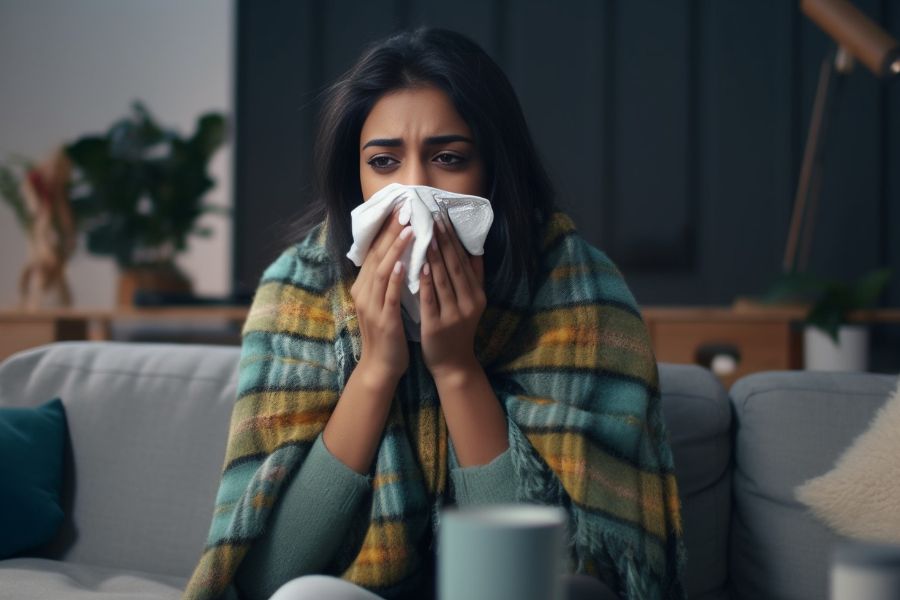We’ve all heard the term “air quality,” but how often do we think about the air inside our homes? We may forget to consider signs of air pollutants in our personal spaces.

Learn more about signs that the air inside your home is polluted and ways to improve it.
Unpleasant Odors
If you regularly notice unpleasant, musty odors in your home, it could indicate polluted air. Common sources of bad smells are mold, mildew, and even volatile organic compounds (VOCs) emitted from paint, cleaning products, and air fresheners.
To reduce these odors, invest in natural cleaning supplies and ventilate your home. While it’s tempting to use air fresheners to mask unpleasant odors, try using essential oil diffusers or potpourri instead.
Feeling Unwell at Home
Do you or your family members often feel unwell at home, exhibiting symptoms such as headaches, dizziness, nausea, or tiredness? These feelings could be the result of breathing polluted indoor air caused by VOCs and even biological pollutants like mold and pet dander.
Keep your home sanitary to improve indoor air quality. Adding air-purifying greenery like spider plants, snake plants, and peace lilies to your living spaces can also improve indoor air quality.
Allergy Symptoms
If your family members frequently suffer from allergy symptoms—sneezing, coughing, itchy eyes, and throat irritation—poor indoor air quality could be the culprit. Pollen, mold spores, dust mites, and pet dander make life uncomfortable for you and your loved ones.
To reduce allergy triggers, clean your home regularly and thoroughly. Use a vacuum with a HEPA filter, and change your bedding and towels every few weeks. Air purifiers provide numerous health benefits, including the reduction of allergy symptoms you experience at home.
Excessive Humidity
High humidity in your home worsens air quality by encouraging the growth of mold, mildew, and dust mites. These irritants worsen allergy symptoms, create unpleasant odors, and even damage your home’s structure. Ideal indoor humidity levels are anywhere around 25 percent.
Invest in a hygrometer to monitor moisture in the air. Then, purchase a dehumidifier or an air conditioner for your home. Also, don’t forget to use exhaust fans in your kitchen and bathroom to suck up water vapor and regulate indoor air quality.
Keeping the air in your home clean is crucial for your family’s health and comfort. By recognizing these signs of indoor air pollution, you can improve the air quality in your residence. Simple changes can make a big difference when you want to breathe better in the place you call home.
Keeping the air in your home clean is crucial for your health and well-being. Here are some effective strategies you can implement:
Reduce pollutants and allergens:
- Minimize dust: Regularly vacuum carpets and rugs, dust furniture, and wash bedding and curtains frequently. Use high-filtration air filters in your vacuum cleaner and HVAC system.
- Control humidity: Keep indoor humidity levels below 50% to prevent mold and mildew growth. Use a dehumidifier in damp areas like bathrooms and basements.
- Manage ventilation: Open windows for fresh air circulation regularly, especially after cooking or cleaning. Ensure bathroom and kitchen exhaust fans vent outdoors.
- Control sources: Avoid smoking indoors, burning candles or incense, and using harsh chemical cleaners. Choose low-VOC paints and cleaning products.
- Address pests: Get rid of dust mites, rodents, and other pests that contribute to indoor allergens.
Filter and purify the air:
- Air purifier: Consider investing in an air purifier with HEPA filters to remove airborne particles like dust, pollen, and pet dander. Choose one suitable for the size of your room.
- Plants: Certain plants like peace lilies, snake plants, and spider plants can help filter indoor air pollutants. However, they shouldn’t be solely relied upon for significant air purification.
Additional tips:
- Change air filters regularly: Replace your HVAC system’s air filters as recommended by the manufacturer, usually every 1-3 months.
- Clean and maintain appliances: Regularly clean your oven, range hood, and bathroom exhaust fans to prevent grease and dust buildup.
- Monitor air quality: Consider using an air quality monitor to track indoor pollutants and adjust your cleaning and ventilation strategies accordingly.
By following these tips, you can create a cleaner and healthier living environment for yourself and your loved ones. Remember, consistency is key!
I hope this information helps! Feel free to ask if you have any further questions.
Related Posts:
- How To Improve Your Home Environment With Windows and Indoor Air Quality
- How Often Should You Clean Your Air Ducts?
- Indoor Air Quality Matters: How Your HVAC System Can Improve The Air You Breathe
- Make Sure You and Your Skin are Breathing Clean Air: Indoor Air Quality
- How to Clean the Air in Your Home (Clarifion Review)